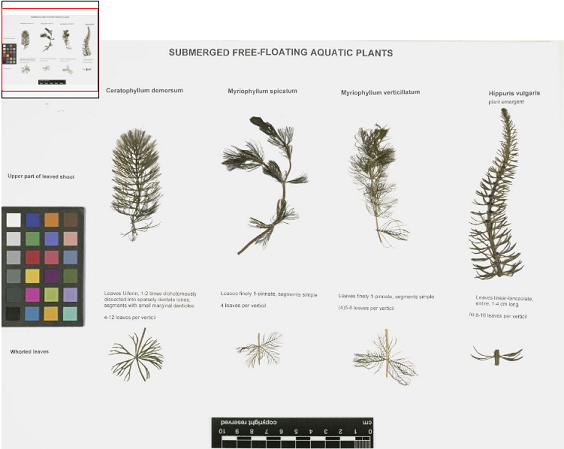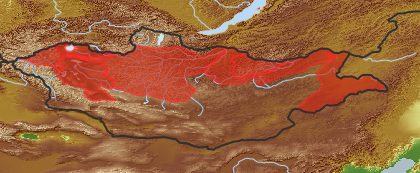| Class: | angiosperms |
| Order: | Rosales |
| Family: | Urticaceae |
| Genus: | Parietaria |
| Scientific name: | Parietaria micrantha Ledeb. |
| Name acc. to: | Gubanov 1996 |
| Herbar: | list records  |
| Synonym: | P. debilis auct. Fl. Mong., non Forst.fil. |
| Description: | Very thin delicate annual with prostrate or ascending stem, alternate leaves, without stipules and without stinging hairs.
Inflorescence cymose, 3-5-flowered.
 |
| Link to Flora of China: | http://www.efloras.org/browse.aspx?flora_id=2&name_str=Parietaria+micrantha |
| open map in a new window |  |
| Habit (i)general appearance of a plant | |
| Growth form: (i)Herb, shrub, tree or climber. | annual (i)Completing its life cycle within one year or one growing season; roots weak and thin  inherited by genus Parietaria: annual inherited by genus Parietaria: annual
herb (i)Herbaceous, erect plant, up to 2m high, mostly with a leafy shoot; if perennial, shoots die to the ground each season, shoots are not woody
example: Artemisia pectinata   inherited by family Urticaceae: herb inherited by family Urticaceae: herb  inherited by genus Parietaria: herb inherited by genus Parietaria: herb
|
| Parasite status: (i)Is the plant a half- or full parasite? | no parasite/saprophyte (i)Plant fully autonomous, leaves with chlorophyll
example: Most plants, Ranunculus  inherited by family Urticaceae: no parasite/saprophyte inherited by family Urticaceae: no parasite/saprophyte
|
| Water or terrestrial plant: (i)Where do the plants grow? | terrestrial (i)Plant grows on dry land
example: Orostachys spinosa  inherited by family Urticaceae: terrestrial inherited by family Urticaceae: terrestrial
|
| Leaf (i)expanded, usually photosynthetic organ of a plant (including phylloclades) | |
| Leaf development: (i)Structure and development of leaves. | with green leaves (i)Plant with green leaves  inherited by family Urticaceae: with green leaves inherited by family Urticaceae: with green leaves
|
| Leaf arrangement: (i)Arrangement of leaves at the stem. | alternate (i)One leaf per node; distiche: arranged in two vertical rows, equitant
example: Phragmites    inherited by genus Parietaria: alternate inherited by genus Parietaria: alternate
|
| Simple or divided leaves: (i)Are the leaves simple or completely divided in several parts? Blade of the leaf entire or (more or less) deeply dissected. Attention: There are various appearances of the leaf margin (from entire to toothed and lobed). Here, we ignore this and ask only for dissections that separate the leaf for more than one third of its length or width, whatever is smaller. Sometimes, it is difficult to tell apart compound leaves from a shoot system with simple leaves: look for stipulae and/or axillary buds at the ground of the leaves: if only some possess these structures, the others are most likely leaflets of a compound leaf. | simple (i)Non-divided leaf, but margin may be incised nearly to the ground   inherited by family Urticaceae: simple inherited by family Urticaceae: simple
|
| Petiole: (i)Leaf divided into stalk (petiole) and blade. | with (i)Leaves with petiole (stalk)   inherited by family Urticaceae: with inherited by family Urticaceae: with
|
| Stipule: (i)Leaflets at the base of the petiole, these are smaller and of different shape. | none (i)Without stipules
example: Euphorbia, Ericaceae s.l.  inherited by family Urticaceae: none inherited by family Urticaceae: none
|
| Leaf veination: (i)Arrangement of the main veins of a leaf. | pinnate (i)One main vein, several side veins, sometimes inconspicuous
example: Cicerbita     inherited by family Urticaceae: pinnate inherited by family Urticaceae: pinnate
|
| Flower (i)reproductive portion of the plant, consisting of sepals, petals, stamens, and pistils | |
| Flower appearance and pollination: (i)General appearance of the flower. | not attractive, wind-pollinated or some water plants (i)Small, colourless or green flowers
example: Betula, grasslike plants: Carex, Setaria, Juncus  inherited by family Urticaceae: not attractive, wind-pollinated or some water plants inherited by family Urticaceae: not attractive, wind-pollinated or some water plants
|
| Flower colour: (i)Attention: assess colour of the most colourful parts of the flower, but not of the stamens; be aware of single plants with a mutation (mostly white) on flower colour. | colourless (i)Dry membranous  inherited by family Urticaceae: colourless inherited by family Urticaceae: colourless
greenish (i)petals absent or not distinctly different from colours of leaves, only stigmas (white) or anthers (yellow) may differ in color
example: Chenopodium, Triglochin  inherited by family Urticaceae: greenish inherited by family Urticaceae: greenish
|
| Perianth arrangement: (i)Attention: in some plants, flowers may be dimorphic in different ways (dioecious or gynodioecious). If flowers vary, record the characters of the most showy flowers. | simple, similar (i)Only one type of perianth leaves (tepals)
example: Tulipa   inherited by family Urticaceae: simple, similar inherited by family Urticaceae: simple, similar
|
| Diameter of flower: (i)Diameter of flower or flower head. | to 5 mm (i)
example: Aruncus  inherited by family Urticaceae: inherited by family Urticaceae:
|
| Flower symmetry: (i)Symmetry of the perianth leaves. Attention: to assess this character, look on sepals, petals and stamens, but neglect carpels and ovary. | radiary, regular (actinomorphic) (i)More than two axis of symmetry
example: Saxifraga: 5; Iris: 3   inherited by family Urticaceae: radiary, regular (actinomorphic) inherited by family Urticaceae: radiary, regular (actinomorphic)
|
| Flower form: (i)common forms of flowers ? Veronica | simple (flat) - Do not confuse with inflorescences as in some Asteraceae (i)Petals spread out, flower appearing flat
example: Mollugo, Trientalis, Pulsatilla, Saxifraga   inherited by family Urticaceae: simple (flat) - Do not confuse with inflorescences as in some Asteraceae inherited by family Urticaceae: simple (flat) - Do not confuse with inflorescences as in some Asteraceae
|
| Petal / Tepal number: (i)Number of petal leaves (inner perianth leaves, usually coloured). | 3 (i)
example: Iris  inherited by family Urticaceae: 3 inherited by family Urticaceae: 3
4 (i)
example: Galium  inherited by family Urticaceae: 4 inherited by family Urticaceae: 4
|
| Petal / Tepal fusion: (i)To which degree are the petal leaves connected? Petals sympetalous. | free (i)all petal leaves separate from each other
example: Anthriscus  inherited by family Urticaceae: free inherited by family Urticaceae: free
|
| Spur: (i)A hollow, slender, sac-like appendage of the perianth leaves, storing nectar. | no spur (i)Flower without appendage
example: Peganum  inherited by family Urticaceae: no spur inherited by family Urticaceae: no spur
|
| Stamen number: (i)Attention: We ask for the reproductive organs of the flower dispersing pollen. Count only fully fertile stamens, not staminodia (e.g. Parnassia). | 3 (i)
example: Poa, Iris  inherited by family Urticaceae: 3 inherited by family Urticaceae: 3
4 (i)Extremely rare, may be absent
example: Plantago  inherited by family Urticaceae: 4 inherited by family Urticaceae: 4
|
| Stamen fusion: (i)To which degree are the stamens fused? Attention: Whereas the pollen sacs itself are often free., their stalks (filaments) may be fused. Here, we count them as fused if they are together over at least one thirth of their length. | free (i)Stamens with separate bases
example: Malus  inherited by family Urticaceae: free inherited by family Urticaceae: free
|
| Pistil number: (i)Number of pistils (female floral organs: style, if developed; stigma and carpels/ovary together build the pistil). | 1 (i)One carpel, but clearly one stigma
example: Pyrola, Primula, Alyssum  inherited by family Urticaceae: 1 inherited by family Urticaceae: 1
|
| Carpel number: (i)Number of carpels (carpel: forming a simple pistil or part of a compound pistil, modified leaf). | 1  inherited by family Urticaceae: 1 inherited by family Urticaceae: 1
2  inherited by family Urticaceae: 2 inherited by family Urticaceae: 2
3  inherited by family Urticaceae: 3 inherited by family Urticaceae: 3
|
| Style number: (i)Portion of the pistil connecting the stigma to the ovary. | 1  inherited by family Urticaceae: 1 inherited by family Urticaceae: 1
2  inherited by family Urticaceae: 2 inherited by family Urticaceae: 2
3  inherited by family Urticaceae: 3 inherited by family Urticaceae: 3
|
| Stigma number per style: (i)Number of stigmas per style. | > 3 (i)More than three stigmas, resulting from more than three fused carpels with or without develped style  inherited by family Urticaceae: > 3 inherited by family Urticaceae: > 3
|
| Ovary position: (i)For entirely or partly fused carpels, describe their position in relation to the insertion point of perianth leaves (best done by doing a longitudinal section of a flower). | superior (hypogynous) (i)Base of carpels attached above insertion point of perianth leaves, carpels free or fused
example: Delphinium, Anemone    inherited by family Urticaceae: superior (hypogynous) inherited by family Urticaceae: superior (hypogynous)
|
| Sex: (i)Distribution of male and female organs among flowers, only most commonly cases. | unisexual (i)
example: Rhodiola  inherited by family Urticaceae: unisexual inherited by family Urticaceae: unisexual
dioecious (i)Male and female flowers at different individuals
example: Antennaria  inherited by family Urticaceae: dioecious inherited by family Urticaceae: dioecious
|
| Inflorescence (i)flowering part of a plant, describes the arrangement of the flowers on the flowering axis | |
| Inflorescence: (i)Structure of the inflorescence. | Flowers in inflorescence (i)No solitary flowers  inherited by family Urticaceae: Flowers in inflorescence inherited by family Urticaceae: Flowers in inflorescence
Compound inflorescences (i)Flowers on shoots of higher orders (complex branched)
example: Solidago   inherited by family Urticaceae: Compound inflorescences inherited by family Urticaceae: Compound inflorescences
|
| Appearance: (i)Outer look of the inflorescence. | axillary (i)Usually several inflorescences in axillary shoots or single flowers in leaf axils, main shoot remains mostly leafy
example: Tragopogon, Aconogonon  inherited by family Urticaceae: axillary inherited by family Urticaceae: axillary
|
| Fruit (i)the seed bearing organ, with or without adnate parts; a ripened ovary and any other structures which are attached and ripen with it. Aggregate fruits are handled like simple fruits for determination. | |
| Consistency: (i)Fleshy fruits or dry fruits, see dispersal adaptations for further classification. | dry (i)With a dry outer shell, no fleshy parts, but seed (embryo) could be edible  inherited by family Urticaceae: dry inherited by family Urticaceae: dry
|
| Type of fruit: (i)Common fruit types (including pseudocarp). | Indehiscent fruits  inherited by family Urticaceae: Indehiscent fruits inherited by family Urticaceae: Indehiscent fruits
Solitary fruits (i)     inherited by family Urticaceae: Solitary fruits inherited by family Urticaceae: Solitary fruits
nut or nutlet (i)Dry fruit with a single, hard stone inside (and usually a large often edible embryo)   inherited by family Urticaceae: nut or nutlet inherited by family Urticaceae: nut or nutlet
|
| Dispersal: (i)Appearance of fruit or seed (if single) and adaptations to dispersal. | Otherwise (i)All parts dry, no conspicuous adaptations  inherited by family Urticaceae: Otherwise inherited by family Urticaceae: Otherwise
|
| Seed number: (i)Estimate the number of seeds per fruit, if recognizable seeds are in the fruit (in rare cases a fruit may contain one seeded nuts: rose hip, carex). | 1 (i)A single seed (stone) or seed and fruit wall tightly connected
example: Prunus, Amygdalus: drupe  inherited by family Urticaceae: 1 inherited by family Urticaceae: 1
|
| Root / shoot below ground (i)plant part below ground (in most cases), including below ground shoots, without leaves | |
| Root type: (i)Organisation of the roots. | allorhizous (i)Plant with a conspicuous tap root, one larger tap root with side roots
example: Dicotyledonae  inherited by order Rosales: allorhizous inherited by order Rosales: allorhizous
|
| Distribution (i)region where the plant is likely to be found | |
| Distribution (Veg. Zones): (i)acc. to Grubov 1952 | Khentei (i)In distribution data often named as '2' 
Khangai (i)In distribution data often named as '3' 
Mongol-Daurian (i)In distribution data often named as '4' 
Khobdo (i)In distribution data often named as '6' 
East Mongolia (i)In distribution data often named as '9' 
Depression of Great Lakes (i)In distribution data often named as '10' 
acc. to: Gubanov 1996 |
| Distribution Khangay: (i)acc. Flora Khangaya 1989 | III
V
|